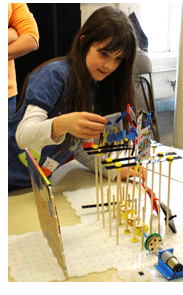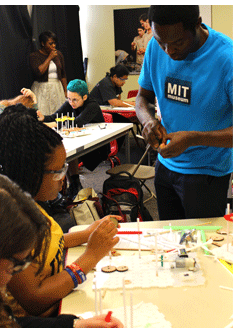Moving STEM to STEAM @ the MIT Museum
From Faith Marie Dukes
 The MIT Museum provides a space where the general public can learn about current and past research at MIT. Its vast collections include everything from nautical plans to stroboscopes. The historical robots currently on display exhibit more than 50 years of innovations in computer science and artificial intelligence at MIT. However, when we solely focus on the traditional science, technology, engineering and math (STEM) offerings of the Museum and MIT, we miss the wonderful connections of art, science and technology that have been created on campus and displayed at the Museum. The MIT Museum’s collection of holograms and strobe photography by Doc Edgerton and Berenice Abbott excite both the scientific mind and the artistic eye. They are valuable examples of how art and science can be equally incorporated. However, it is the work of Arthur Ganson that has inspired us to create our newest art and engineering educational offering at the Museum. By adding the ‘A’ for art into this particular STEM lesson, we’ve achieved a marriage of art and engineering for a true STEM to STEAM experience. The MIT Museum provides a space where the general public can learn about current and past research at MIT. Its vast collections include everything from nautical plans to stroboscopes. The historical robots currently on display exhibit more than 50 years of innovations in computer science and artificial intelligence at MIT. However, when we solely focus on the traditional science, technology, engineering and math (STEM) offerings of the Museum and MIT, we miss the wonderful connections of art, science and technology that have been created on campus and displayed at the Museum. The MIT Museum’s collection of holograms and strobe photography by Doc Edgerton and Berenice Abbott excite both the scientific mind and the artistic eye. They are valuable examples of how art and science can be equally incorporated. However, it is the work of Arthur Ganson that has inspired us to create our newest art and engineering educational offering at the Museum. By adding the ‘A’ for art into this particular STEM lesson, we’ve achieved a marriage of art and engineering for a true STEM to STEAM experience.
 Make to Move, our kinetic art and engineering workshop, combines the use of simple machines and everyday objects to create moving masterpieces. Officially launched in January 2015, the workshop helps teachers meet school science standards through a hands-on learning experience that instructs students in the creation of rotary, linear and oscillating motions using pulleys, cams, linkages, and gears. Interesting and dynamic results occur Make to Move, our kinetic art and engineering workshop, combines the use of simple machines and everyday objects to create moving masterpieces. Officially launched in January 2015, the workshop helps teachers meet school science standards through a hands-on learning experience that instructs students in the creation of rotary, linear and oscillating motions using pulleys, cams, linkages, and gears. Interesting and dynamic results occur  when students are also given playing cards, a rubber spider, or plastic pinwheels. Inspiration from and the incorporation of a “found object” have led to fascinating art exhibitions within our classroom. What begins as a lesson in mechanical engineering, ends with creative titles and moving monuments. when students are also given playing cards, a rubber spider, or plastic pinwheels. Inspiration from and the incorporation of a “found object” have led to fascinating art exhibitions within our classroom. What begins as a lesson in mechanical engineering, ends with creative titles and moving monuments.
The most exciting observation has been the full engagement of students during this exercise regardless of age, gender or background. For them, the experience has been both challenging and entertaining. Education consultants have helped observe student participation throughout the workshop’s development. This has been critical in the evolution of the educational format and physical tools used to create the experience. This STEAM exploration is just one of the ways the Museum is exploring the intersection of art and science/technology through our galleries and informal classroom. We are excited to see what STEAM creations come next!
Faith Marie Dukes is the Education Coordinator at the MIT Museum in Cambridge, MA.
Back to newsletter |